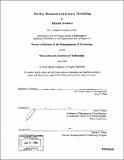The key elements of advocacy marketing
Author(s)
Yamaoka, Takashi, 1968-
DownloadFull printable version (7.020Mb)
Other Contributors
Massachusetts Institute of Technology. Management of Technology Program.
Advisor
Glen L. Urban.
Terms of use
Metadata
Show full item recordAbstract
Customer power is growing, and customers now have tools that inform them of the true state of affairs. This power enables them to avoid the pushy messages of marketers, make their own decisions, and determine what to buy. A company advocates for its customers and earns their trust. It may not be a strategy for everyone, but innovative companies are following this path. The marketing paradigm is shifting from traditional push-based marketing to trust-based advocacy marketing. This research identifies and summarizes the key elements needed to create customer advocacy. It considers the following research questions: What are the key elements to creating customer advocacy? What means or types are there in each key element? Which elements are influential on advocacy marketing in each company and industry? The author sent out requests for interviews to many firms and received affirmative replies from about thirty. Based on the data gathered by the author, twelve new key elements were identified, and several means for realizing these elements, which can be distilled in several ways. These key elements and means are effective for firms in a variety of industries and categories. In addition, the author introduces a new framework which can effectively identify a firm's position in terms of two dimensions: push and trust. This framework is useful for confirming differences between competitors and validating corporate strategies for building and maintaining competitive advantage. Few firms can afford to ignore advocacy marketing as a marketing strategy. Advocacy marketing is associated not only with customer marketing, but also with overall corporate strategy. This research will focus on enriching practical knowledge for the (cont.) real world, and be a useful reference when a company launches its advocacy marketing campaigns.
Description
Thesis (S.M.M.O.T.)--Massachusetts Institute of Technology, Sloan School of Management, Management of Technology Program, 2004. Includes bibliographical references (leaves 140-142).
Date issued
2004Department
Management of Technology Program.; Sloan School of ManagementPublisher
Massachusetts Institute of Technology
Keywords
Management of Technology Program.